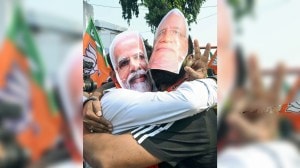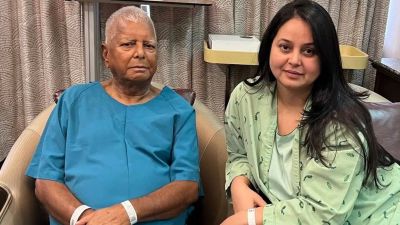One convicted for murders of 10 Dalits after 42-year wait: ‘Is this what justice looks like?’
Dispute over which court would hear the case after Firozabad district was created in 1989 delayed the verdict by nearly 32 years
 Premwati was just 30 when she and her children — sons Harishankar, 12, and Kailash, 8, and daughter Sukhdevi, 14 — were shot in the kitchen of their house. While the children died on the spot, Premwati survived. (Express Photo by Amit Mehra)
Premwati was just 30 when she and her children — sons Harishankar, 12, and Kailash, 8, and daughter Sukhdevi, 14 — were shot in the kitchen of their house. While the children died on the spot, Premwati survived. (Express Photo by Amit Mehra) The wind was howling through the streets of Firozabad’s Sadhupur village — then in Mainpuri district — that chilly evening on December 30, 1981. The clock had struck 6 pm but it was pitch-black outside. Premwati, then just 30, sat in the dingy kitchen with her sons Harishankar, 12, and Kailash, 8, as her 14-year-old daughter Sukhdevi made rotis.
Suddenly, two men entered the kitchen. A third man in a police uniform stood outside the main door as a lookout. For five minutes, the two men fired indiscriminately. Sukhdevi was shot in the stomach, Harishankar in the neck and Kailash in the chest and stomach — all three died on the spot.
Somehow, Premwati survived. Shot in the leg, a walking stick would become her permanent companion. It would also become a stark reminder of the day when 10 persons, including six women, belonging to the Schedule Castes were massacred by men belonging to the gang led by dacoit Anar Singh Yadav.
Nearly 42 years later — the creation of a new district in 1989 adding about 32 years to the long wait — a Firozabad court pronounced its judgment in the Sadhupur massacre case on May 31. While two of the accused — Anar and Japan Singh — died during the pendency of the case, 90-year-old Ganga Dayal, who was convicted under Sections 302 (murder) and 307 (attempt to murder) of the Indian Penal Code (IPC), was sentenced to life imprisonment and also fined Rs 50,000.
 Convict Ganga Dayal’s eldest son Jai Praksh, 62, a farmer in Nangla Khar, continues to believe that his father is innocent and was framed in the case. Jai Praksh said he plans to file an appeal against the verdict by the Firozabad District and Sessions Court. (Express Photo by Amit Mehra)
Convict Ganga Dayal’s eldest son Jai Praksh, 62, a farmer in Nangla Khar, continues to believe that his father is innocent and was framed in the case. Jai Praksh said he plans to file an appeal against the verdict by the Firozabad District and Sessions Court. (Express Photo by Amit Mehra)
“Is this what justice looks like? I spent my whole life waiting for justice. And I get justice now?” cried Premwati, 72, as she sat next to her husband Ram Bharose, 82, in the very house where her children were shot dead nearly four decades ago.
The new district
Firozabad district general counsel Rajeev Upadhyay, who appeared for the victims, said the creation of a new district in 1989 delayed the verdict as a lot of time was spent on deciding where the trial should take place.
“When this incident happened, the Shikohabad police station (under whose jurisdiction Sadhupur village fell) was in Mainpuri district. In 1989, the Firozabad district was formed and Shikohabad became a part of the new district. Because the case had already started in Mainpuri district, there were arguments over which district court should hear this matter,” said Upadhyay, adding, “It was a while before the (Allahabad) High Court chose the Firozabad court. After that, the accused kept seeking adjournments. That delayed the case further.”
 Premwati’s husband Ram Bharose, who lost his eyesight nearly 10 years after the incident, survived because he was at a neighbour’s house at the time of the attack. He said despite being promised free electricity for life by the government — since the dacoits had taken advantage of the fact that there was no electricity in the village — the administration has after nearly four decades started sending them power bills and threatening action over non-payment. (Express Photo by Amit Mehra)
Premwati’s husband Ram Bharose, who lost his eyesight nearly 10 years after the incident, survived because he was at a neighbour’s house at the time of the attack. He said despite being promised free electricity for life by the government — since the dacoits had taken advantage of the fact that there was no electricity in the village — the administration has after nearly four decades started sending them power bills and threatening action over non-payment. (Express Photo by Amit Mehra)
As she recalls the carnage, her eyes filling with tears, her throat choking up and her lips trembling, Premwati said, “Everything happened so fast. For a moment, I could not understand what was happening. I was completely numb. I didn’t feel any pain despite being shot in the leg. They just started shooting. They didn’t ask us anything. They didn’t give us a chance to speak. All I can remember is someone saying, ‘Chalo, ho gaya kaam (Let’s go. It’s done)’.”
Half of Premwati’s family was wiped out that day. The only survivors were Ram Bharose, Premwati and their son Mahendra Singh, then just 2. Now 44, Mahendra survived only because he was lying in another room that evening. Ram Bharose, who lost his eyesight nearly 10 years after the incident, survived only because he was at a neighbour’s house. The wizened man recalled running towards his house as soon as he heard the unending pop of bullets.
Mahendra, who works as a labourer to support his family of seven — his wife, six daughters and one son — said, “The government promised jobs on compassionate grounds to each victim’s family members. I have been trying to get that job since I turned 18. I have written multiple letters to the government. In response, I am sent from one office to another.”
Two of Mahendra’s siblings — a brother and a sister who were born after the shooting — too failed to secure the promised job.
A few houses away, Ram Naresh said he had only heard about how his 60-year-old grandmother Chameli Devi was gunned down that day. The 36-year-old grew up listening to stories from his father Ram Ratan about her brutal massacre. He said his father died last year and with him died the fight for the promised job on compassionate grounds. Ram Naresh said his father was appointed as a peon for just one year.
 Kishan Swaroop was just 16 when he hid under a cot as soon as he heard the gunfire. He lost three members of his family that day, including his brother Suresh. A fire later on destroyed almost every document and all photographs of the deceased. All Swaroop is left with is an undated newspaper cutting, yellow with age, of his brother Suresh’s body. The photo caption states: “18 year old Suresh: What was my fault?” (Express Photo by Amit Mehra)
Kishan Swaroop was just 16 when he hid under a cot as soon as he heard the gunfire. He lost three members of his family that day, including his brother Suresh. A fire later on destroyed almost every document and all photographs of the deceased. All Swaroop is left with is an undated newspaper cutting, yellow with age, of his brother Suresh’s body. The photo caption states: “18 year old Suresh: What was my fault?” (Express Photo by Amit Mehra)
“He was appointed as a peon at a regional employment office in Agra (over 80 km from the village) in 1982 but dismissed a year later. No explanation was given for his removal,” said Ram Naresh, showing multiple letters written by his father to the district administration seeking the reason for his dismissal. He added, “Four people were given jobs on compassionate grounds but only two still continue to hold their posts. The others were removed without any explanation.”
In response to the Firozabad Additional District Magistrate seeking a clarification, a letter dated July 6, 2009, by the regional employment office of Agra division states that Ram Ratan’s services were terminated on “28.02.1983 due to non-receipt of order from the Government/Directorate to maintain the continuity of the post”.
That night continues to haunt 58-year-old Kishan Swaroop. A boy of mere 16, he saved his life that night by diving under a cot as soon as he heard the gunfire. He lost three members of his family that day and a fire later consumed almost every document and all photographs of the deceased persons. All Swaroop has to remember them by is an undated newspaper cutting, yellow with age, showing a photograph of his brother Suresh’s body. The photo caption states: “18 year old Suresh: What was my fault?”
One of the main witnesses in the case, Swaroop said, “I heard gunfire in my street. I ran inside the house and hid under the cot. A kerosene lamp was lit inside. That’s how I saw the dacoits. Three of them entered the house and opened fire. They killed my brother Suresh (18), my mother Parvati (60) and sister-in-law Sheela Devi (28).”
 The letter left by dacoit Anar Singh in a gali in Firozabad’s Sadhupur village — then in Mainpuri district — after the December 30, 1981, murders. The letter vows that “there will be more crime” over the “persecution” of Anar’s relatives by the police. Proven genuine by a handwriting expert, the letter was taken on record.
The letter left by dacoit Anar Singh in a gali in Firozabad’s Sadhupur village — then in Mainpuri district — after the December 30, 1981, murders. The letter vows that “there will be more crime” over the “persecution” of Anar’s relatives by the police. Proven genuine by a handwriting expert, the letter was taken on record.
In days that followed, Swaroop said, the village turned into a fortress due to the arrival of state and national leaders such as former Prime Minister Chaudhary Charan Singh, then Union Home Minister Giani Zail Singh and then UP Chief Minister VP Singh. Two other VIP visitors — Atal Bihari Vajpayee and Chandrashekhar — would go on to become Prime Ministers.
“Since the dacoits had attacked us taking advantage of the darkness — there was no electricity in the village at that time — the government promised the village free electricity for life. The government kept its word for a while. Now, almost four decades later, we are being given electricity bills. The administration has threatened to put us in jail if we don’t pay up. This is like putting salt on our wounds,” said Swaroop.
Bhagwan Singh was just a toddler when his grandmother Saguna Devi, aunt Sheela Devi and uncle Suresh were shot in cold blood. The 44-year-old said, “This (the murders) happened because of hatred against the Jatavs. Even today, the Jatavs have a separate cremation ground. We cannot even burn our dead on the same ground as the other castes. When this massacre happened, the leaders promised a memorial for the deceased. That promise still remains unfulfilled.”
He added, “The incident continues to haunt us to date. We are victims of one of the biggest caste crimes in the country but the government hasn’t given us the promised jobs. In fact, even basic amenities like water and sanitation have not been implemented in the village. This treatment is shameful.”
The Indian Express also reached out to Ganga Dayal’s family. After the shooting, he left his ancestral village Gadh Dansahy, around 25 km from Sadhupur, and moved nearly 50 km away to Nangla Khar village. To a question on caste discrimination, Ganga Dayal’s eldest son Jai Praksh, 62, a farmer in Nangla Khar, said, “There may be casteism everywhere, but we do not discriminate on the basis of caste.”
 After the December 30, 1981, shooting, convict Ganga Dayal left his ancestral village Gadh Dansahy, around 25 km from Sadhupur, and moved nearly 50 km away to Nangla Khar village.
After the December 30, 1981, shooting, convict Ganga Dayal left his ancestral village Gadh Dansahy, around 25 km from Sadhupur, and moved nearly 50 km away to Nangla Khar village.
Despite the conviction, Jai Praksh continues to believe that his father is innocent. He said, “My father was not in Sadhupur that day. Due to personal enmity, someone got his name put in the police complaint. The administration has put an old man in jail since May 31. We will file an appeal.”
In the order dated May 31, Session judge Harvir Singh of the Firozabad District and Sessions Court said, “The evidence produced by the prosecution in this case establishes the presence of the accused (Ganga Dayal) at the place of occurrence. The statements of eyewitnesses establish the fact that when the accused came to their house, they were present inside and saw them. The evidence presented by the prosecution does not indicate any conclusion other than the guilt of the accused Ganga Dayal.”
The aftermath of the massacre
After the sound of gunfire in the village died, Sadhupur village pradhan Munichandra immediately despatched someone to inform the Assistant Station Master (ASM) of Makkhanpur railway station about the carnage. The ASM passed on the information to DC Gautam, the then Chief Clerk of Shikohabad railway station, located around 15 km from the village. Gautam hurriedly called up the police. On the basis of that telephonic conversation, the Shikohabad police station registered an FIR around 9.15 pm against Anar, Japan and Ganga Dayal.
Ramesh Chandra, a witness in the case from the nearby Shivram Gadhi village, said that on the eve of the Sadhupur massacre, Anar and his gang threatened him into providing them shelter for the night.
 The Shikohabad police station registered an FIR around 9.15 pm against Anar Singh, Japan Singh and Ganga Dayal based on a telephonic conversation with the then Chief Clerk of Shikohabad railway station. After the carnage, information about the incident was sent to the Assistant Station Master (ASM) of Makkhanpur railway station, who passed it on to Chief Clerk of Shikohabad railway station, located around 15 km from the village.
The Shikohabad police station registered an FIR around 9.15 pm against Anar Singh, Japan Singh and Ganga Dayal based on a telephonic conversation with the then Chief Clerk of Shikohabad railway station. After the carnage, information about the incident was sent to the Assistant Station Master (ASM) of Makkhanpur railway station, who passed it on to Chief Clerk of Shikohabad railway station, located around 15 km from the village.
“I was sleeping outside my house. It was around 1 am. Three men came to me and said they wanted to stay there for the night. Out of fear, I gave them space to stay and locked the gate from outside,” Chandra said in his witness statement in court.
He added, “The next day, Anar Singh asked me to get a blank paper and pen. He said he would topple the government and commit such a massacre that CO Tyagi (Shikohabad Circle Officer Ramsharan Tyagi) would learn a tough lesson. Anar Singh kept on speaking and I kept on writing. He made me sign the letter. When I asked him what he planned to do with the letter, he said he would see how (UP CM) VP Singh and CO Tyagi would hold on to their positions after this letter. Then, Anar Singh put his stamp on the letter.”
Raghuvir, now 61 years old, shows the said letter — which he got laminated since it was an important proof of the crime — that the gang left in a village gali after the murders. Initial paragraphs in the letter express Anar’s anger over the “persecution” of his relatives by “arresting innocent people and keeping them in the police station for 20-20 days”. The letter vows that “there will be more crime” because of this “harassment”.
The letter was examined by handwriting expert Shiv Prasad Mishra, who proved that it was genuine. Taking the letter on record, the court said, “Accused Anar Singh (deceased) had enmity with Shikohabad Circle Officer Mr. Tyagi and he had the impression that the poor people were being tortured by the government. In this sequence, this act has been done by waging war against the government, in which ten people died, while the dead people had no fault in any way, but to prove their supremacy, Anar Singh and his other members fired indiscriminately on helpless people.”
Sadhupur shooting was the second attack on members of the SC community in the district. On November 18, 1981, 24 people belonging to the Jatav community were murdered in Deoli village, around 30 km from Sadhupur, by a gang of 16 armed attackers led by two Thakur youths wearing fake police uniforms.
Raghuvir remembers the visit by Savita Ambedkar, the wife of Dalit rights champion BR Ambedkar, to the village after the massacre. There were talks by the victims’ kin regarding leaving the village but Savita Ambedkar inspired them to stay put and fight for their rights.
“I was around 18 then. In that one visit, she left a huge impact on us. She said, ‘If you go somewhere else, what will you do when people there attack you too? Will you run away from there also? This is not the solution. Stay in your home, fight or die, but don’t leave it’. So they stayed and fought back,” said Raghuvir.
Despite the deaths and the verdict, much remains the same in the village even today. Bhagwan added, “Caste discrimination is very much prevalent here even now. Even today, when we have a dispute with the Yadavs on any issue, they taunt us by saying, ‘Bhul gaye kya woh din (have you forgotten that day)?’.”








